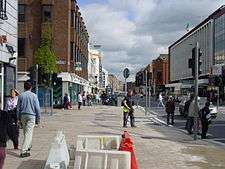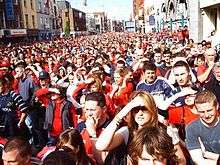O'Connell Street, Limerick
O'Connell Street (Irish: Sráid Uí Chonaill) is the main thoroughfare of the city of Limerick. It was previously known as George's Street (after George III) until it was renamed after Daniel O'Connell. The street runs in parallel to the River Shannon and forms part of an overall thoroughfare, along with Rutland Street and Patrick Street, that bisects Limerick City Centre in a north east to south west direction. The street is about a mile in length, starting at the Arthurs Quay / Denmark Street junction and ending at The Crescent. A monument to Daniel O'Connell stands at the centre of The Crescent overlooking O'Connell Street. The street is noted for its Georgian architectural heritage.
- O'Connell Street is also the main street in Dublin, Ennis, Sligo and in various other towns around Ireland, and also the main street of North Adelaide
 | |
| Native name | Sráid Uí Chonaill (Irish) |
|---|---|
| Former name(s) | George's Street |
| Namesake | Daniel O'Connell |
| Length | 700 m (2,300 ft) |
| Width | 20 metres (66 ft) |
| Location | Limerick, Ireland |
| Postal code | V94 |
| Coordinates | 52.661916°N 8.628741°W |
| northeast end | Patrick Street, Denmark Street |
| southwest end | The Crescent, Hartstonge Street |
| Other | |
| Known for | shops, restaurants, Limerick Rugby Museum, St Augustine's Church, banks |
Retail & Services

Retail outlets on O'Connell Street include Brown Thomas, Debenhams and Penneys, while O'Mahony's have a large bookstore there founded in 1902. The George Hotel is also located on the street, which also acts as a regional financial services centre with a number of large retail banking operations, including Bank of Ireland, AIB, Ulster Bank and KBC Bank.
A study carried out by the CBRE Ireland Research Team in 2012 found that 16% of retail units on O'Connell Street were vacant,[1] making it the worst performing main city thoroughfare in Ireland in retail terms.[1] The results also reflected poorly on the quality of retail offered on O'Connell Street with Limerick having the greatest proportion of fast food restaurants on its main street, at 21%, followed by footwear at 13%, and jewellery stores at 5%; this was in stark contrast to other Irish cities and towns where women's fashionwear occupies the core retail slots on the main streets and also offer a more mixed fashion offering.[1]
The Belltable Arts Centre, located at 69 O'Connell Street, is a multi-disciplinary venue which houses a 250-seat theatre/cinema, a 50-seat balcony studio (for occasional poetry and smaller performances), a visual arts gallery (hosting up to 12 exhibitions a year) and a basement restaurant. It hosts the Unfringed Festival, which is Limerick's only performance festival in spring.[2]
History
.jpg)
O'Connell Street dates from the late 18th to early 19th century as part of Edmund Sexton Pery's plan for the development of a new city on lands he owned to the south of the existing medieval city. In 1765, he commissioned the engineer Davis Ducart to design a town plan on those lands which have since become known as Newtown Pery. The centrepiece of this development was O'Connell Street. The street along with the rest of Newtown Pery was built to Georgian design and is part of Limerick's Georgian Quarter.
The street prospered from the time of its construction and quickly attracted the city's wealthier residents who then resided in the Englishtown area of medieval Limerick. The cramped and lofty Dutch styled dwellings of Englishtown and Irishtown were no match for the new, grand and spacious housing & thoroughfares of Newtown Pery. Although the street functioned as the main retail & commercial district of the city, this was (and remains today) primarily focused on the northern end of the street. The southern end of the street, in contrast, was more residential in character with the barrier being located about midway on the street (from the Cecil Street junction). Today, most of the residential townhouses on the street are now occupied by offices.
.jpg)
From the 1950s onwards due to accidental damage from fire, neglect and poor planning by the city authorities a lot of the Georgian heritage has been lost on the northern end of the street around the retail core and has had an overall negative impact on the appearance of the street. Notable architectural losses include the façades of Cannock's Department store and its landmark clock tower (now Penney's), Todd's Department Store (now Brown Thomas) and Cruises Hotel (now Cruises Street) amongst many more. Nevertheless, some of the finest examples Georgian townhouse architecture in Ireland still survives on the southern end and along the Crescent area of the street.
For a time the O'Connell Street & William Street/Sarsfield Street junction was historically an important crossroads junction in the west of Ireland with four national primary routes converging at the one place. The N7 from Dublin and the east, the N18 from Galway and the north, the N20 from Cork & Kerry and the south west and the N24 from Waterford and the south east all converged at the one place. Most of O'Connell Street was part of the N20 prior to the opening of the Limerick Southern Ring Road in 2004. It now forms part of the R527 regional road.
Irish Civil War
O'Connell Street was the location of the main incidents of the Irish Civil War in Limerick. The anti - treaty forces largely held four military barracks and most of the town while the Free state forces in the city held Cruises Hotel on O'Connell Street (along with Customs House, the Jail, the Courthouse, William Street RIC Barracks which were all located nearby). During this time Limerick saw much street fighting between the opposing forces which lasted three days. The fighting resulted in 15 deaths, seven of whom were civilians and eight Free State soldiers. Another 87 were wounded. (See: Irish Free State offensive)
Todd's Fire
On 25 August 1959, Limerick's best known department store was the scene of the city's largest and most destructive fire. Todd's which occupied a large city block fronting onto O'Connell Street (now occupied by Brown Thomas) and William Street went on fire following an electrical fault.[3] At 11 a.m. smoke was noticed coming from the William Street side of the store and by 12.30 the whole block became a blazing inferno.[3] The fire spread and destroyed the stores adjoining Todd's including at the time Burtons, Liptons, Goodwins and Cesars which were completely gutted.[3] A new store was built in place of the old store which was held by some to be a less attractive design, and which completely altered the appearance of the street.
Cruises Street development
In the early 1990s one of Limerick's main landmarks - Cruises Hotel was demolished to make way for a new pedestrian street 'Cruises Street' at the northern end of O'Connell Street. The street was constructed to bring high end retailers to the city centre.
Events

- On 20 May 2006, O'Connell Street was closed so that 50,000 could crowd the street to watch the Heineken Cup Final, Munster vs. Biarritz on a massive screen.
- On 24 May 2008, the street was closed again so that crowds could watch the Heineken Cup Final between Munster and Toulouse on a massive screen.
- The Munster Rugby homecoming ceremony was also held on O'Connell Street on both occasions.
- In September 1998 thousands gathered in O'Connell Street for a speech given by the then President of the United States, Bill Clinton.
- In May 1964, thousands lined O'Connell Street as senator Ted Kennedy gave a speech from Cruises Hotel. The visit came just 5 months after the assassination of his brother John F. Kennedy who had also visited Limerick in 1963.[4][5]
- The annual St. Patrick's Day parade takes place on O'Connell Street every year on the 17 March as well as the annual Limerick International Marching Band Competition which takes place on the weekend nearest to St. Patrick's Day.
Present
O'Connell Street, along with much of Limerick city centre, is in decline and has been for some time. Some of the reasons for this are:
- the depopulation of the city centre from the 1950s onwards
- the movement of industry and State services from city centre areas to suburban areas, and lack of replacement
- what some hold to be a disastrous retail strategy by the local authorities (Limerick City Council and Limerick County Council), that saw (in some cases) the construction of large shopping centres in suburban areas, now more accessible by car to the general public with a better selection of shops, and in direct competition with City Centre traders.
- upward-only rent reviews, the economic collapse of 2008 onwards coupled with the reduction of footfall on the street, and an unemployment rate in the city of 28.6% (CSO figures released in 2012), that resulted in the closure of many of the stores on O'Connell Street which accelerated the decline from 2008 onwards
- high vacancy rates on streets leading to O'Connell Street with little or no retail offering or business activity on Rutland Street, Patrick Street (The Opera Centre) or Sarsfield Street.
See also
- Cruises Street
- William Street
- Henry Street
- Newtown Pery
- Daniel O'Connell
- Edmund Sexton Pery
References
- 16% of shops vacant on Limerick’s main thoroughfare - Local Business - Limerick Leader
- Belltable Arts Centre
- "Fire of Todd's Department Store on Tuesday, 25 August 1959". Limerickslife.com. Retrieved 2012-10-01.
- Limerick remembers Senator Ted Kennedy RIP - Leader Local - Limerick Leader
- TED KENNEDY IN IRELAND - British Pathé